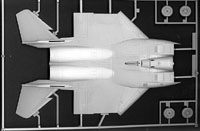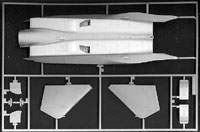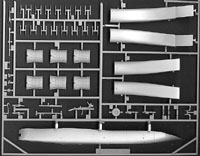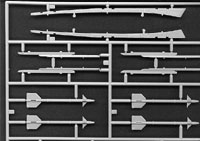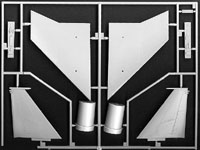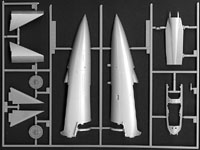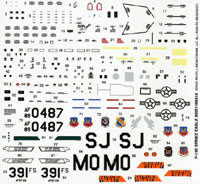



Revell's 1/48 F-15E Strike Eagle
By Frank Anselmo
History
In the early 1980s, the USAF recognized that a replacement platform was required for the aging General Dynamics F-111 strike aircraft fleet. After looking into a variety of alternatives, the USAF selected the McDonnell Douglas F-15 Eagle to be the platform for the follow-on strike role. Based on the two-seat F-15B/D, the F-15E Strike Eagle would retain the time-proven two-man crew configuration in an airframe that could incorporate the latest in avionics and weapons capabilities.
Externally, the only thing that really distinguishes the F-15E from its air superiority brothers is the dark grey paint job and different mounts on the conformal fuel tanks (CFTs). While the F-15C/Ds also have the CFT, they only have AIM-7 launchers installed, whereas the F-15E CFT has a variety of weapons store mounts to support a number of weapons capabilities.
Up close, the F-15E back office is a state-of-the-art station with multiple glass displays for the APG-70 radar, LANTIRN sensor and laser designator system, and aircraft management systems. The LANTIRN pods mount underneath the intake trunks, though it is not uncommon to see the F-15E without the LANTIRNs installed. There are a variety of other differences (strengthened landing gear, EW sensors, etc.), but while the F-15E is a solid strike platform, it also retains the air-to-air capabilities of the earlier F-15s.
In Desert Storm, the F-15E proved to be a versatile deep strike platform, roaming deep into Iraqi airspace to hunt Scuds and other targets of opportunity. During one such mission, the F-15E crew spotted an Iraqi helicopter below in a hover. Rather than descend and engage the helicopter with a missile, the crew fired off the LANTIRN laser designator and rippled off a laser-guided bomb. A kill is a kill...
The KitFor those of us that have long anticipated the release of the Revell F-15E Strike Eagle in 1/48 scale, the wait is finally over. It was well worth it, however. "The Eagle has finally landed." The box art features a Strike Eagle in the markings of Seymour Johnson AFB on a Scud hunting mission during Operation Desert Storm. Upon opening the large box you will find five sprues of gray plastic, along with a sprue of crystal clear transparencies. The moulding of the parts is nothing short of fantastic, with no flash evident on any of the parts. The recessed panel lines are very delicate, and could be the best that Revell has done for a plastic aircraft kit. But the best thing about this kit is that we finally have an accurate 1/48 scale kit of the F-15E.The kit includes the clip-load fairing on the bottom of the fuselage, along with bulged main wheel well doors molded in the closed position, which is the correct position when the aircraft is parked on the ground. The correct stub pylons and long pylons are also included. None of these items are included in the Hasegawa release, which is nothing more than the original demonstrator aircraft with the original wing weapons pylons. The reinforcing plates at the top of the vertical tails are also scribed onto both vertical tails in the kit.The cockpit has fine molded detail, but there is room for improvement for those that desire to add it. Black Box will be issuing a cockpit detail set for those that wish to have greater detail in their cockpit. This should be available around May 1 if my source on this is correct.You will also find a beautiful set of afterburner nozzles and control rods all molded in plastic, along with two wing fuel tanks, and AIM-9L Sidewinder missles. There are no other weapons included in the kit. However, for the price of this kit, one could go out and buy a Hasegawa Weapons Set, and still be money ahead. In order to bring the Hasegawa kit up to production standards, you will have to purchase a Paragon Productions update set, or do a lot of scratch building. So for the cost of the Hasegawa kit and an update set, you could buy two or three copies of the Revell kit and Hasegawa Weapons Sets, depending on where you purchase these kits.There is also a stiffener that runs along the horizontal stabilizers that must be a late modification to the aircraft. Also included for late model Mudhens is an intake scoop that is not mentioned in the instructions, but is on the parts tree for addition if the model you are building needs them. This is particularly true for aircraft stationed at Lakenheath, England.The decal sheet contains the markings for two aircraft. The first is for an aircraft from the 335th TFS of the 4th TFW from Seymour Johnson AFB that particiapated in Operation Desert Storm. The other is for the squadron commanders aircraft of the 391st FS of the 366th FW based at Mountain Home, Idaho. These markings are so complete that they include the tiger stripes that are painted on the main wheel hubs. There is also a complete set of stencils for one aircraft on the decal sheet.On my kit there was a probe on the left fuselage that had broken off in shipment. I called Revell for a replacement part and was told it should arrive in about 10 days. It showed up neatly packaged in 5 days.The only negative item that I can find on the kit is that the horizontal stabilizers are molded attached to the main fuselage. It would have been nice if we would have been given the option to place them in other than the neutral position.ConclusionWhen all things are considered, this is a very fine aircraft kit. I am tempted to call this probably the best aircraft kit that Revell has ever produced. "The biggest bang for the buck" is definitely there in this kit. |

Previous: Contents


